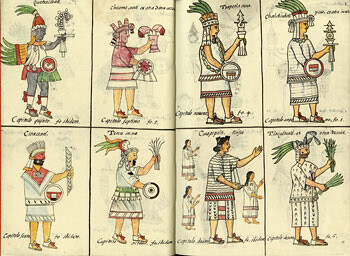April 30 – May 1, 2010
Getty Villa
17985 Pacific Coast Highway
Pacific Palisades, California 90272
http://www.getty.edu
INTERNATIONAL SCHOLARS COME TOGETHER AT THE GETTY MUSEUM FOR A SYMPOSIUM ADDRESSING HISTORICAL ANALOGIES BETWEEN THE AZTECS AND ANCIENT ROMEAltera Roma: Art and Empire from the Aztecs to New Spainat the Getty Villa on Friday, April 30, and, Saturday, May 1
Scholars from around the world will gather at the Getty Villa on April 30 and May 1, 2010, to explore one of history’s most momentous confrontations, an encounter between two cultures, European and Mesoamerican, and two empires, Spanish and Aztec. The two-day symposium is presented in conjunction with the exhibition The Aztec Pantheon and the Art of Empire, on view at the Getty Villa through July 5, 2010.
The symposium is presented in association with the Cotsen Institute of Archaeology at the University of California, Los Angeles, and is made possible by the generous support of Chase.
The exhibition and accompanying symposium examine the contexts in which classicism mediated a dialogue between Mesoamerica and Europe in the 1500s–1700s, when parallels were routinely drawn between the Old World past and the pre-Hispanic cultures of the New World. More specifically, the symposium will address cross-cultural analogies in the early modern period, as well as current comparative approaches to the archaeology of empire. Topics include the notion of parallel pantheons and classical paradigms for Aztec culture; the representation of Aztec life in post-conquest Mexico and Europe; monumental art as an imperial strategy and the Florentine Codex, an iconic chronicle of Aztec culture from the Biblioteca Medicea Laurenziana in Florence, Italy.
Distinguished international speakers and contributors comprise many of the top experts in the field of classicism and Pre-Columbian art including Elizabeth Hill Boone, Tulane University, New Orleans; Thomas B.F. Cummins, Harvard University, Cambridge, Massachusetts; Guilhem Olivier Durand, Universidad Nacional Autónoma de México, Mexico City; Jonathan Edmondson, York University, Toronto; Eulogio Guzmán, Tufts University, Boston; Cecelia F. Klein, University of California, Los Angeles; Andrew Laird, University of Warwick, England; Leonardo López Luján, Museo del Templo Mayor/INAH, Mexico City; David Lupher, University of Puget Sound, Tacoma; Anthony Pagden, University of California, Los Angeles; John Pohl, University of California, Los Angeles; Alessandra Russo, Columbia University, New York City; Walter Scheidel, Stanford University, California, and Emily Umberger, Arizona State University, Tempe.
The symposium is open to the public for 15 USD per day and 10 USD per day for students. The fee includes parking, coffee/tea service, and reception on Friday evening. Advance registration for each day required. To register for the symposium, visit www.getty.edu or call (310) 440-7300.
In addition to the symposium, there will also be a public lecture on the Florentine Codex at the Getty Villa on Thursday, April 29. Diana Magaloni Kerpel, director of the Museo Nacional de Antropología in Mexico City, shares her research on the Codex. Created by Bernardino de Sahagún and a group of Nahua scholars between 1575 and 1577, the Codex is an encyclopedic study of Aztec history and culture. Accompanying its Spanish and native Nahuatl language texts are some 2,500 ink and watercolor drawings. The Codex’s illustrations can be read as a third hidden text, reflecting both the pre-Hispanic tradition of painting-writing employed to record human history and the classical legacy of Renaissance Europe. The centerpiece of the exhibition, The Aztec Pantheon and the Art of Empire, the Codex returns to the Americas for the first time in over 400 years for the exhibition.
The Aztec Pantheon and the Art of Empire
On view at the Getty Villa through July 5, 2010
Celebrating the bicentennial of Mexican independence, The Aztec Pantheon and the Art of Empire presents extraordinary masterworks of Aztec sculpture, largely from the collections of the Museo Nacional de Antropología and the Museo del Templo Mayor in Mexico City, represents the J. Paul Getty Museum’s first display of antiquities from outside the ancient Mediterranean as well as the first exhibition on the Aztec empire to be organized in Los Angeles.
For symposium schedule and registration info, please visit http://www.getty.edu/museum/symposia/alteraroma.html
Image above: Aztec Deities
Bernardino de Sahagún
Historia general de las cosas de Nueva España (General History of the Things of New Spain), also called the Florentine Codex vol. 1,
1575-1577
Watercolor, paper, contemporary vellum Spanish binding
Biblioteca Medicea Laurenziana, Florence, Italy, FI 100 Med.Palat. 218
Courtesy of the Ministry of Heritage and Culture.
Further reproduction is prohibited by any means.

